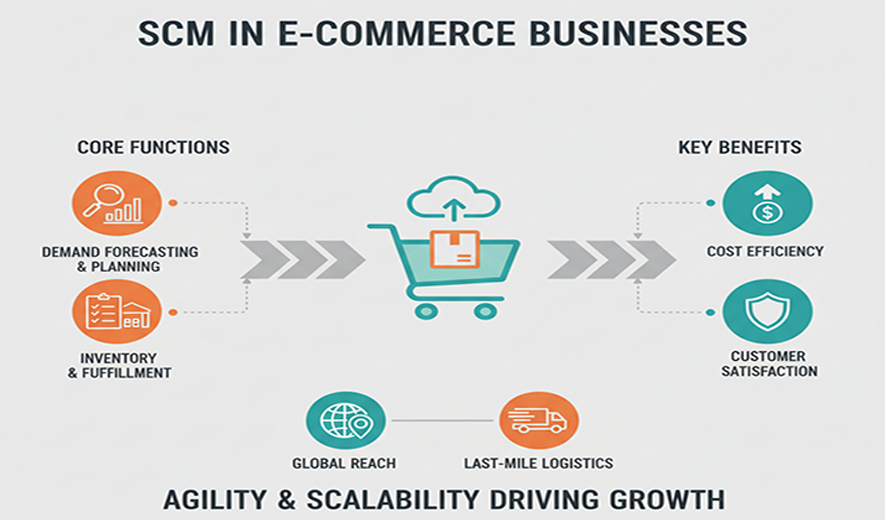
SCM in E-commerce Businesses
Supply chain management (SCM) is the strategic coordination of operations that are particularly critical to the success of e-commerce businesses. Because online retailers lack a physical storefront, the supply chain directly shapes the customer experience, from order fulfillment to timely delivery and returns. Effective SCM is the backbone of a successful e-commerce operation, ensuring that the right product reaches the right customer at the right time and at the lowest possible cost.
Unique challenges of e-commerce SCM
E-commerce SCM must navigate challenges that traditional retail does not, largely due to the high volume of small, individual orders and heightened consumer expectations.
- Last-mile delivery: This final leg of delivery is complex and expensive, often accounting for more than half of the total shipping cost. Challenges include route inefficiencies, traffic congestion, and failed delivery attempts.
- Inventory management: Keeping optimal stock levels is challenging because demand is often unpredictable and varies across multiple sales channels. Inaccurate tracking can lead to costly stockouts or overstocking.
- Reverse logistics: Managing returns is a frequent and costly process for online businesses. An inefficient return system can hurt profitability and customer satisfaction.
- Scalability: The supply chain must be agile enough to handle seasonal surges in demand (e.g., during holidays) and adapt to rapid business growth.
- Global sourcing: Many e-commerce businesses source products internationally, which adds complexity due to extended lead times, regulatory issues, and global disruptions.
Key strategies and best practices
To build a successful e-commerce supply chain, businesses must leverage technology, streamline operations, and focus on the customer experience.
Fulfillment and delivery
- Partner with 3PLs: Third-Party Logistics providers offer expertise, technology, and a network of warehouses that can help e-commerce businesses scale efficiently.
- Use multiple fulfillment centers: Storing inventory in various strategic locations closer to customers reduces shipping zones, lowers transportation costs, and speeds up delivery times.
- Micro-fulfillment centers: Placing smaller warehouses in urban areas helps shorten last-mile delivery distances, enabling services like same-day delivery.
- Optimize last-mile delivery: Use AI-powered route optimization software to create the most efficient delivery paths, reducing fuel costs and delivery times.
Inventory and warehouse management
- Implement advanced software: An inventory management system (IMS) tracks stock in real-time, helping prevent stockouts and overstocking across all sales channels.
- Automate order processing: Warehouse Management Systems (WMS) use automation for tasks like picking, packing, and generating shipping labels, which reduces human error and speeds up fulfillment.
- Adopt omnichannel capabilities: For retailers with both online and physical stores, an integrated system is necessary to manage inventory seamlessly across all channels.
Forecasting and visibility
- Improve demand forecasting: Use AI, machine learning, and historical sales data to create more accurate forecasts. Incorporating external factors like market trends and seasonal changes further refines predictions.
- Enhance supply chain visibility: Technology like IoT sensors and blockchain can provide real-time tracking of goods. This ensures transparency for customers and helps businesses proactively manage disruptions.
- Use a data-driven approach: Leverage supply chain analytics to monitor KPIs, identify inefficiencies, and make more informed decisions about planning and sourcing.
Customer service and returns
- Streamline reverse logistics: An efficient process for returns and exchanges is critical for customer satisfaction. Automated return labels and clear communication simplify the process.
- Set customer-centric policies: Reliable delivery times, accurate order tracking, and flexible delivery options build trust and enhance the overall customer experience.
